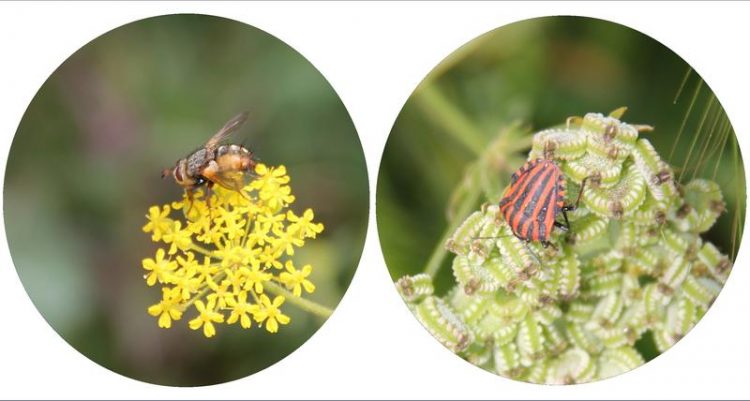Hundreds of novel viruses discovered in insects

Insects can harbour viruses. Sofia Paraskevopoulou
New viruses which cause diseases often come from animals. Well-known examples of this are the Zika virus transmitted by mosquitoes, bird flu viruses, as well as the MERS virus which is associated with camels.
In order to identify new viral diseases quickly and prevent possible epidemics, DZIF scientists at Charité – Universitätsmedizin Berlin are targeting their search at viruses in animals. In a current study, they have now discovered hundreds of novel viruses in insects. The results have been published in the specialist journal PLOS Pathogens.
“Every new virus we find could be a cause of illnesses that was previously unknown, both in humans and in livestock,” explains Professor Christian Drosten, Director of the Institute of Virology on Campus Charité Mitte.
The scientist is a specialist for virus discovery and diagnostics at the German Center for Infection Research (DZIF). For example, his team has defined the international standard approach for diagnosing MERS. He is currently focusing on rare virus diagnoses using new sequencing techniques. “The more viruses we identify and add to our database, the easier it is for us to recognise the cause of new and unusual illnesses,” says Drosten.
Current study
In the current study within the framework of the DZIF working group on “Virus detection and preparedness”, the research team has made use of the largest international transcriptome database on insects, a kind of calalogue of gene acitivity, and investigated the data it contains with regard to virus genomes.
Whilst scientists have previously concentrated on mosquitos and other blood-feeding insects, this study includes all groups of insects. Viruses with negative strand RNA genomes have been systematically investigated. This group of RNA viruses includes important pathogenic viruses; these cause Ebola and measles, as well as rabies and lung infections.
Search databases for new viruses
In a total of 1243 insect species, the researchers discovered viruses that can be classified in at least 20 new genera. “This is probably the largest sample of animals ever screened for new viruses,” says Drosten. The working group has already added the new insect viruses to its search databases. With the help of these data, it will now be possible to investigate cases of rare and unusual illnesses in humans.
This includes patients who display all the symptoms of a viral infection, however no virus can be identified in the case in question. “In such cases, we use high-throughput sequencing methods to search for all the viruses present in the patient,” explains Drosten.
“If the patient has a virus, we will find it, provided it is in our database or has similarities with a virus in our database.” The chances of the search being successful will increase thanks to the addition of the new insect viruses.
Within the framework of the DZIF project “Virus detection and preparedness”, scientists at Charité focus on anticipating and detecting future viral threats.
Professor Dr Christian Drosten
Charité – Universitätsmedizin Berlin
German Centre for Infection Research
T: +49 30 450 525 091
Email: christian.drosten@charite.de
Käfer S, Paraskevopoulou S, Zirkel F, Wieseke N, Donath A, Petersen M et al (2019): Reassessing the diversity of negative strand RNA viruses in insects.
PLoS Pathog 15(12):e1008224. https://doi.org/10.1371/journal.ppat.1008224
Media Contact
More Information:
http://www.dzif.deAll latest news from the category: Life Sciences and Chemistry
Articles and reports from the Life Sciences and chemistry area deal with applied and basic research into modern biology, chemistry and human medicine.
Valuable information can be found on a range of life sciences fields including bacteriology, biochemistry, bionics, bioinformatics, biophysics, biotechnology, genetics, geobotany, human biology, marine biology, microbiology, molecular biology, cellular biology, zoology, bioinorganic chemistry, microchemistry and environmental chemistry.
Newest articles

Silicon Carbide Innovation Alliance to drive industrial-scale semiconductor work
Known for its ability to withstand extreme environments and high voltages, silicon carbide (SiC) is a semiconducting material made up of silicon and carbon atoms arranged into crystals that is…

New SPECT/CT technique shows impressive biomarker identification
…offers increased access for prostate cancer patients. A novel SPECT/CT acquisition method can accurately detect radiopharmaceutical biodistribution in a convenient manner for prostate cancer patients, opening the door for more…

How 3D printers can give robots a soft touch
Soft skin coverings and touch sensors have emerged as a promising feature for robots that are both safer and more intuitive for human interaction, but they are expensive and difficult…





















